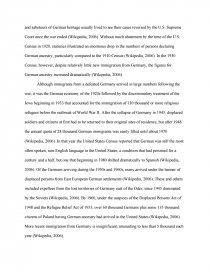Dutch: A Ethnic Group That I Personally Belong
Essay by review • March 16, 2011 • Research Paper • 1,196 Words (5 Pages) • 1,406 Views
Essay Preview: Dutch: A Ethnic Group That I Personally Belong
Dutch: A ethnic group that I personally belong
Michelle Smith
Western International University
ETH 123
Donna Owens
January 21, 2006
When the Dutch immigrated to the United States
From 1820 to 1900 over 340,000 people from Holland immigrated to the United States. After the Second World War Holland was the most-densely populated country in the world (Wikipedia, 2006). As a result the Dutch government encouraged people to immigrate to America. Today there are approximately 8,000,000 Americans of Dutch decent in the United States. The majority live in just ten states: California, New York, Michigan, Pennsylvania, Ohio, Texas, Illinois, Florida, Washington and Iowa (Wikipedia, 2006).
The Dutch faced prejudice and segregation
During the first two years of World War I, hatred and bigotry engulfed the German-born, German-speaking businessmen, wage earners, clergy, and ordinary citizens, not infrequently occasioned by rivalry, competition, and a jealousy for the accomplishments of German immigrants (Wikipedia, 2006). Like pariahs Germans now were hunted down. German newspaper editors were arrested, their enterprises closed down. German-language books were burned by street mobs while officials ordered changed names for towns, streets, parks, buildings, and geographic places (for example, Bismarck to Lincoln, Schiller to Longfellow). Beginning as early as 1916 with President Woodrow Wilson's campaign for reelection, there broke out an exaggerated "war against the hyphen," meaning the German Americans (Wikipedia, 2006). In response many Germans elected to change or Anglicize their names and deny their origins by going underground. Often arrested, fined, and sentenced to long jail terms, perceived dissenters and saboteurs of German heritage usually lived to see their cases reversed by the U.S. Supreme Court once the war ended (Wikipedia, 2006). Without much abatement by the time of the U.S. Census in 1920, statistics illustrated an enormous drop in the numbers of persons declaring German ancestry, particularly compared to the 1910 Census (Wikipedia, 2006). In the 1930 Census, however, despite relatively little new immigration from Germany, the figures for German ancestry increased dramatically (Wikipedia, 2006).
Although immigrants from a defeated Germany arrived in large numbers following the war, it was the German economy of the 1920s followed by the discriminatory treatment of the Jews beginning in 1933 that accounted for the immigration of 130 thousand or more religious refugees before the outbreak of World War II. After the collapse of Germany in 1945, displaced soldiers and citizens at first had to be returned to their original sites of residence, but after 1948 the annual quota of 28 thousand German immigrants was easily filled until about 1970 (Wikipedia, 2006). In that year the United States Census reported that German was still the most often spoken, non-English language in the United States, a condition that had persisted for a century and a half, but one that beginning in 1980 shifted dramatically to Spanish (Wikipedia, 2006). Of the Germans arriving during the 1950s and 1960s, many arrived under the banner of displaced persons from East European German settlements (Wikipedia, 2006). These and others included expellees from the lost territories of Germany east of the Oder, since 1945 dominated by the Soviets (Wikipedia, 2006). By 1960, under the auspices of the Displaced Persons Act of 1948 and the Refugee Relief Act of 1953, over 60 thousand Germans plus some 135 thousand citizens of Poland having German ancestry had arrived in the United States (Wikipedia, 2006). More recent immigration from Germany is insignificant, amounting to less than 5 thousand each year (Wikipedia, 2006).
Racism of the Dutch
Racism and ethnicism were initially produced in the Americas and then expanded to the rest of the colonial world as the foundation of the specific power relations between Europe and the populations of the rest of the world. After five hundred years, they still are the basic components of power relations across the world. Once colonialism became extinct as a formal political system, social power is still constituted over criteria originated in colonial relations. In other words, coloniality has not ceased to be the central character of today's social power.... With the formation of the Americas a new social category was established. This is the idea of "race".... Since then, in the intersubjective relations and in the social practices of power, there emerged, on the one hand, the idea that non- Europeans have a biological structure not only different from Europeans; but, above all, belonging to an "inferior" level or type. On the other hand, the idea that cultural difference is associated to such biological inequalities....
...
...




